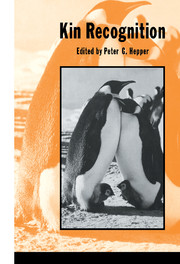Book contents
- Frontmatter
- Contents
- List of contributors
- Preface
- Introduction
- 1 The correlation between kinship and behaviour in non-human primates
- 2 Co-operation and reciprocity in birds and mammals
- 3 Kinship and fellowship in ants and social wasps
- 4 Successes and failures of parent–offspring recognition in animals
- 5 Kinship, kin discrimination and mate choice
- 6 Genetic components of kin recognition in mammals
- 7 Kin recognition in amphibians
- 8 Kin recognition cues of vertebrates
- 9 Recognizing kin: ontogeny and classification
- 10 Parental states as mechanisms for kinship recognition and deception about relatedness
- 11 Fetal learning: implications for the development of kin recognition
- 12 Information processing and storage during filial imprinting
- 13 The honey bee as a model kin recognition system
- 14 Mutual mother–infant recognition in humans
- Author index
- Species and common name index
- Subject index
7 - Kin recognition in amphibians
Published online by Cambridge University Press: 06 January 2010
- Frontmatter
- Contents
- List of contributors
- Preface
- Introduction
- 1 The correlation between kinship and behaviour in non-human primates
- 2 Co-operation and reciprocity in birds and mammals
- 3 Kinship and fellowship in ants and social wasps
- 4 Successes and failures of parent–offspring recognition in animals
- 5 Kinship, kin discrimination and mate choice
- 6 Genetic components of kin recognition in mammals
- 7 Kin recognition in amphibians
- 8 Kin recognition cues of vertebrates
- 9 Recognizing kin: ontogeny and classification
- 10 Parental states as mechanisms for kinship recognition and deception about relatedness
- 11 Fetal learning: implications for the development of kin recognition
- 12 Information processing and storage during filial imprinting
- 13 The honey bee as a model kin recognition system
- 14 Mutual mother–infant recognition in humans
- Author index
- Species and common name index
- Subject index
Summary
Introduction
Kinship underlies many facets of vertebrate sociality. Yet vertebrate societies rarely consist exclusively of kin. Typically, individuals interact both with kin and non-kin in numerous and often unpredictable contexts. Clear advantages accrue to those individuals that discriminate behaviourally among conspecifics based on their genetic relatedness. The ability to recognize relatives permits individuals (1) to favour their kin, thereby enhancing their inclusive fitness (Hamilton, 1964; Grafen, 1985), and (2) to avoid incest or even to choose an optimally related mate (Shields, 1982; Bateson, 1983), potentially increasing their own reproductive success. Possible benefits of kin discrimination are easily enumerated in birds and mammals (reviewed in Waldman, 1988), so their kin recognition abilities (e.g. Holmes & Sherman, 1982; Hepper, 1983; Beecher, 1988) should not be surprising. Less is known about the social life of fishes, amphibians, and reptiles, but they also may recognize their kin. Some fishes and larval amphibians, for example, recognize their siblings and preferentially school with them (e.g. Waldman, 1982b; O'Hara & Blaustein, 1985; Quinn & Busack, 1985; Van Havre & FitzGerald, 1988; Olsen, 1989). Similarly, iguana hatchlings associate in social groups with their siblings rather than with unrelated individuals (Werner et ah, 1987).
Mechanisms of kin recognition have been more thoroughly examined in amphibians than in other vertebrates. Indeed, information on the ontogeny and sensory bases of kin recognition comparable in detail to that known about social insects (e.g. Gamboa et aL, 1986; Hölldobler & Carlin, 1987; Michener & Smith, 1987) and some invertebrates (Linsenmair, 1987) is currently available only for larval amphibians. Warm-blooded vertebrates can be unwieldy as subjects for ontogenetic studies in the laboratory.
- Type
- Chapter
- Information
- Kin Recognition , pp. 162 - 219Publisher: Cambridge University PressPrint publication year: 1991
- 40
- Cited by

